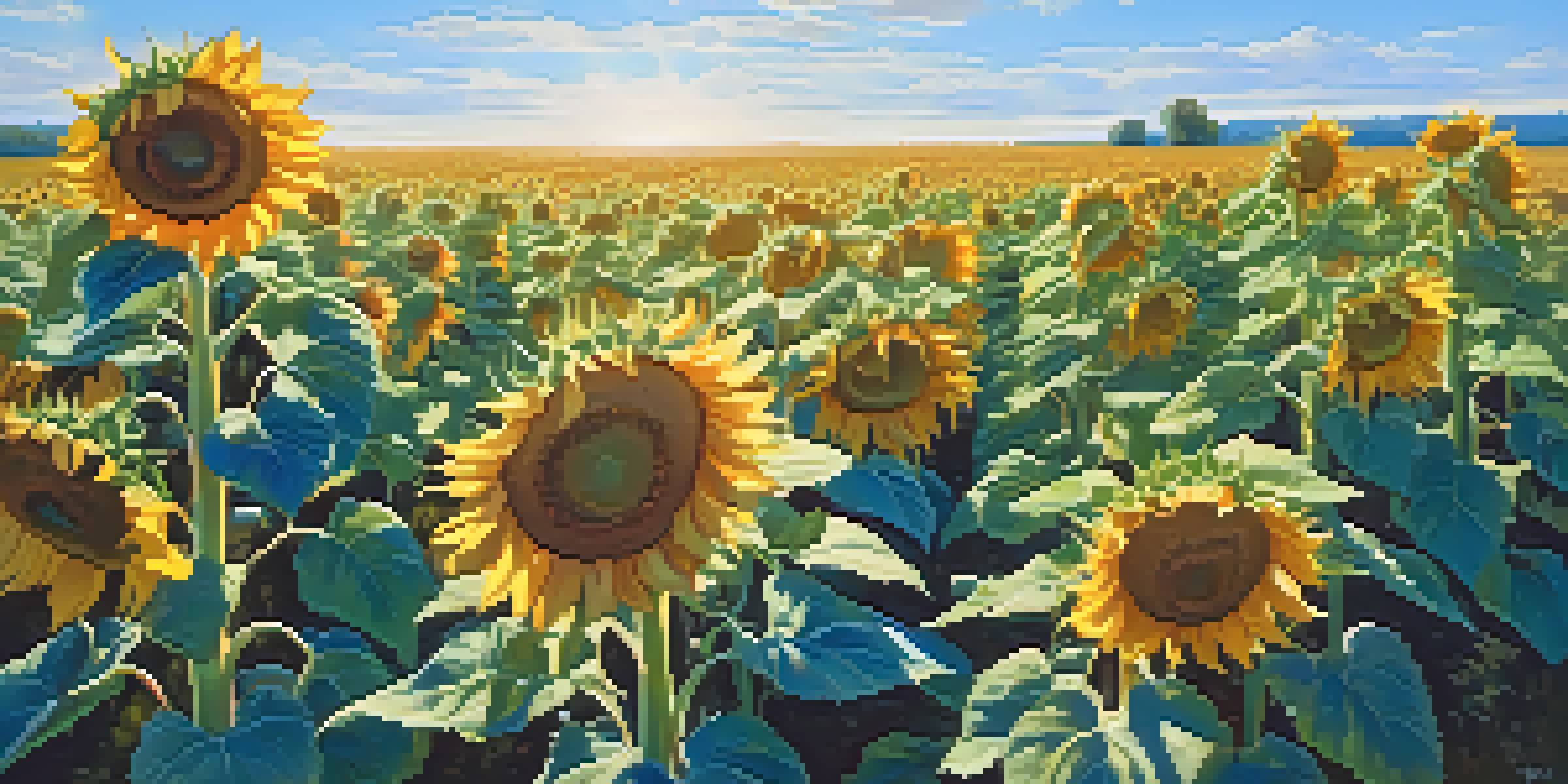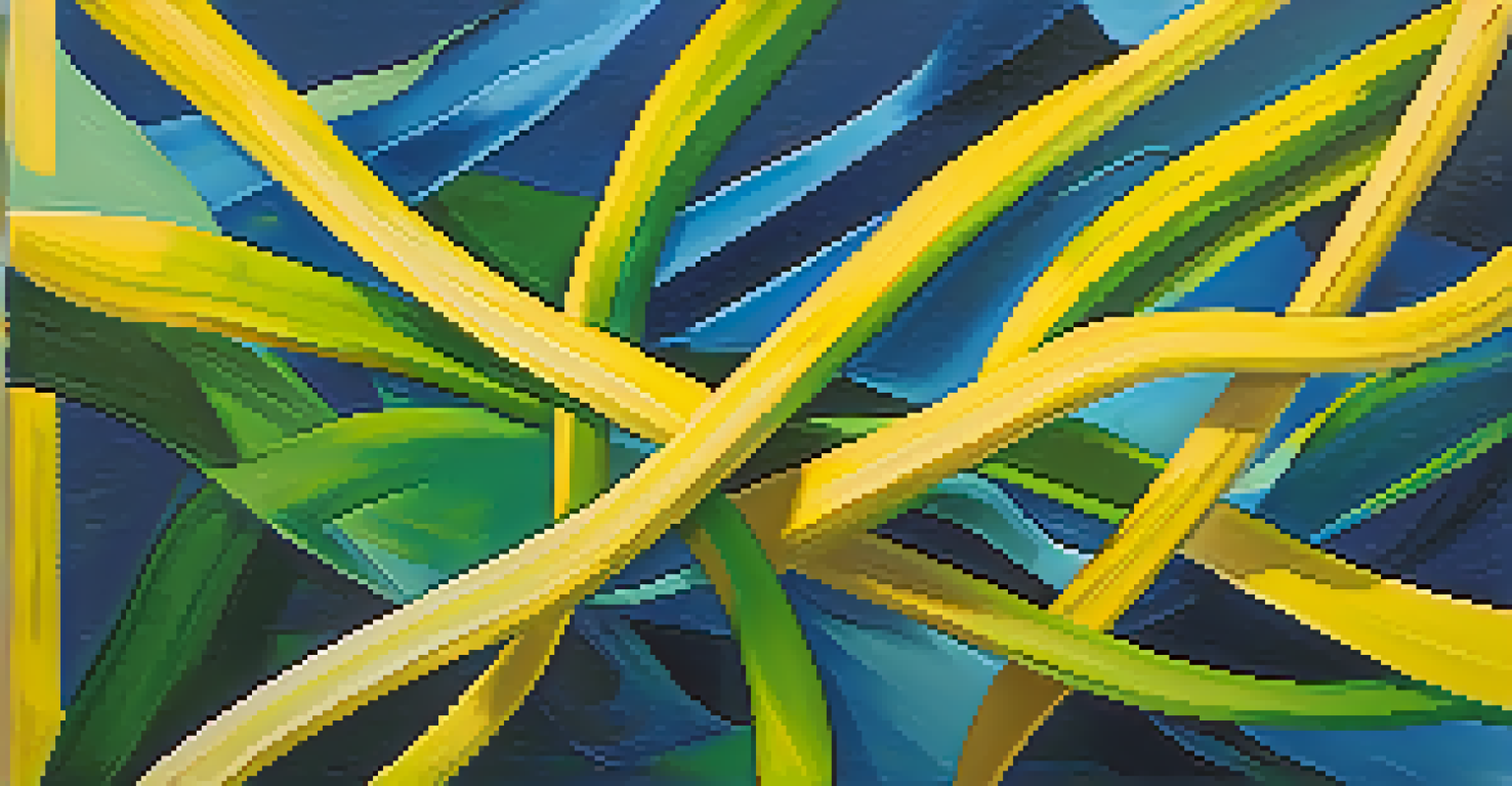The Meaning of Yellow: Joy and Optimism in Visual Art

The Symbolism of Yellow in Art History
Yellow has long been associated with happiness and positivity in visual art. From ancient times to contemporary pieces, artists have used this bright hue to evoke feelings of joy. Think of Van Gogh's sunflowers or Monet's vibrant landscapes; yellow often serves as a focal point that draws viewers in.
Color is the keyboard, the eyes are the harmonies, the soul is the piano with many strings.
In various cultures, yellow signifies different meanings, but joy and optimism frequently dominate. In ancient Egypt, it symbolized the eternal, while in Japan, it represented courage. Such diverse interpretations showcase yellow's universal appeal and its ability to connect with people on an emotional level.
As artists experimented with different styles and mediums, the use of yellow has evolved. Its boldness can create a sense of warmth and energy, inviting the audience to experience life through a more optimistic lens. This vibrant color remains a staple in the palettes of many renowned artists.
Psychological Effects of Yellow on Viewers
The psychological impact of yellow is profound; it has been known to stimulate feelings of happiness and energy. Studies suggest that yellow can elevate mood and even enhance creativity, making it a popular choice for artists looking to inspire and uplift. Imagine walking into a gallery bathed in yellow; it feels almost like stepping into a sunlit day.

However, too much yellow can lead to feelings of anxiety or agitation, showcasing the need for balance in its use. Artists often carefully consider how much yellow to incorporate, aiming to maintain that joyful vibe without overwhelming the viewer. This balance is crucial in creating an inviting atmosphere in their work.
Yellow Symbolizes Joy Across Cultures
Yellow is universally associated with happiness and positivity, with varying meanings in different cultures that enhance its emotional appeal.
Moreover, the interplay between yellow and other colors can amplify its emotional impact. For example, when paired with deep blues or greens, yellow becomes even more vibrant, evoking a sense of harmony. Understanding these psychological effects helps artists convey their intended messages more effectively.
Yellow in Modern and Contemporary Art
In modern and contemporary art, yellow continues to play a significant role. Artists like Yayoi Kusama and Mark Rothko have harnessed the power of yellow to evoke emotion and provoke thought. Kusama's polka dots and Rothko's color fields often incorporate bold yellows, inviting viewers to connect with the work on a deeper level.
Yellow is the color of the sun. It is the color of happiness, optimism, and enlightenment.
Contemporary art movements frequently embrace yellow for its ability to attract attention and convey optimism. Street artists, for instance, use yellow to brighten urban spaces, transforming dull cityscapes into vibrant communities. This practice not only beautifies the surroundings but also uplifts the spirits of those who encounter it.
Additionally, digital art has allowed for innovative uses of yellow, where artists can manipulate light and color in ways not possible with traditional mediums. This evolution expands the possibilities for expressing joy and optimism through art, keeping yellow at the forefront of contemporary creativity.
Cultural Variations in the Meaning of Yellow
The significance of yellow varies across cultures, enriching its role in visual art. In Western societies, it's often linked to happiness and cheerfulness, while in Eastern cultures, it can symbolize wisdom and nobility. This diversity in interpretation allows artists to infuse their work with layered meanings, depending on their cultural context.
For instance, in India, yellow is associated with the spring festival of Basant Panchami, celebrating knowledge and the arrival of warmth. Artists may use yellow to honor these traditions, creating a cultural dialogue between their work and the viewer's experiences. Such connections deepen the impact of the artwork.
Psychological Impact of Yellow
The color yellow can stimulate feelings of happiness and creativity, but must be used in balance to avoid overwhelming viewers.
Understanding these cultural nuances can enhance the viewer's appreciation of a piece. When an audience recognizes the significance of yellow in a particular context, it adds a rich layer to their interpretation, making the experience all the more rewarding.
Yellow in Nature and Its Artistic Inspiration
Nature is a rich source of inspiration for artists, and yellow is prevalent in the natural world. From the bright petals of sunflowers to the warm glow of sunsets, yellow captures the essence of beauty and vitality. Artists often draw from these natural occurrences to create works that resonate with viewers on an emotional level.
The vibrancy of yellow in nature not only symbolizes joy but also represents growth and renewal. For example, the changing colors of leaves in autumn can evoke nostalgia and a sense of hope for new beginnings. Artists can harness these themes to convey messages of optimism and resilience through their work.
Moreover, the way light interacts with yellow in nature can inform an artist's use of the color in their own creations. By observing how sunlight enhances the vibrancy of yellow, artists can recreate that warmth and energy in their pieces, inviting viewers to feel the joy that inspired them.
The Use of Yellow in Color Theory
Color theory plays a significant role in understanding how yellow functions in art. Yellow is a primary color, meaning it cannot be created by mixing other colors, which gives it a unique significance in both art and design. Its brightness makes it a powerful tool for artists aiming to evoke specific emotions or reactions.
In color theory, yellow is often associated with light and warmth. It can create a sense of cheerfulness and vitality, making it an ideal choice for artists looking to capture joy. By strategically placing yellow within their compositions, artists can guide the viewer's eye and evoke the intended emotional response.
Yellow's Role in Contemporary Art
Contemporary artists utilize yellow to evoke emotion and optimism, transforming spaces and experiences through innovative uses of the color.
Furthermore, yellow's relationship with other colors can enhance its impact. When combined with complementary colors like purple, yellow can appear even more vibrant, creating a dynamic visual experience. This interplay is essential for artists seeking to create works that resonate emotionally with their audience.
Celebrating Yellow in Contemporary Art Exhibitions
Contemporary art exhibitions often celebrate the color yellow, showcasing its joyous attributes and emotional depth. Curators may design entire exhibits around the theme of yellow, inviting artists to explore its meanings through various mediums. These showcases offer a platform for dialogue about the significance of color in our lives.
For example, exhibitions featuring yellow may include multimedia installations, paintings, and sculptures that highlight different interpretations of the color. Visitors can immerse themselves in a world of optimism and joy, fostering a sense of community and connection. This shared experience can be incredibly uplifting.

Such exhibitions not only celebrate yellow but also encourage artists to push boundaries in their use of color. By experimenting with yellow in innovative ways, artists can inspire new conversations about joy and optimism, reaffirming the color's enduring relevance in contemporary visual art.